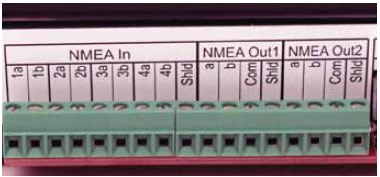
NMEA 2000 (aka NMEA 2K or N2K) is the communication standard replacing NMEA 0183. It is a technical standard (IEC 61162-3) used for connecting marine sensors and display units within a boat. The major differences from NMEA 0183:
- NMEA 2K operates at 250 kilobits-per-second, about 100 times faster than the 4,800 baud of NMEA 0183.
- NMEA 2K networks are created by attaching sensors/instruments and displays to a central backbone cable. The backbone cable provides 12-volt power to most instruments as well as carries data all NMEA 2K sensors and displays connected to the backbone can share.
- NMEA 2K is intended to be plug-and-play. Ideally any NMEA 2K instruments plugged the backbone cable should play nicely with all the other displays and instruments. But note that several proprietary versions (Raymarines SeaTalk NG, Simrads Simnet) use physical connectors that might require adapters to interconnect. NMEA 0183 instruments can also be connected to a backbone through an adapter.
- NMEA 2K also uses the Controller Area Network Bus (CAN Bus) originally developed for on-road vehicles and engines, so engine information (such as fuel consumption, temp, oil pressure) can be transmitted and displayed on the system.
- NMEA 2K is bi-directional, or more accurately, multi-directional. There is no NMEA 0183 talker/listener distinction. Since all instruments can send data on the backbone, the multi-functional display is ideal for the system-you can display info from any or all instruments.
Downsides
The current downsides of NMEA 2K are twofold. First is cost. The compatible instruments are newer and more expensive than older instruments, the cabling is pricey, and the network invites adding many more sensors than you might otherwise consider. Running the cables through an older boat will also be time-consuming and challenging.
Second, if there is a significant problem with the NMEA 2K backbone in a fully NMEA 2K boat-say a crimp and a broken wire, or even a damaged terminator or loose or dirty connector-every instrument depending on the backbone can stop working. We much prefer a system with some redundancy and back-up in it-if an NMEA 0183 instrument, like your speedo or windmeter, quits communicating to your multi-function display or radar through a multiplexer, it will still work on its own.
Further in the future is the still-being-developed NMEA OneNet, also called NMEA on IP (IP being internet protocol). Its a standard for sending data by ethernet cable which will be even faster than NMEA 2K (up to 40,000 times faster), and provide greater bandwidth. Fortunately, OneNet will not replace NMEA 2K but complement it. OneNet will likely open the door for more computer-crossover applications, but it will be several years before OneNet equipment for sailboats will be readily available.






































Hi Darrel, well it has been a few years…
Maybe an article on OneNet revisited…?
I understand the cons it’s the pros I like such as MFD/OneNet Radar and any other signal I want in one place.
I have room on my binnacle for a 10″ MFD.
Maybe with your connections pressure some OEMs to more accurately predict how many years before we can see plug-n-play equipment…?
Fair Winds,
-David